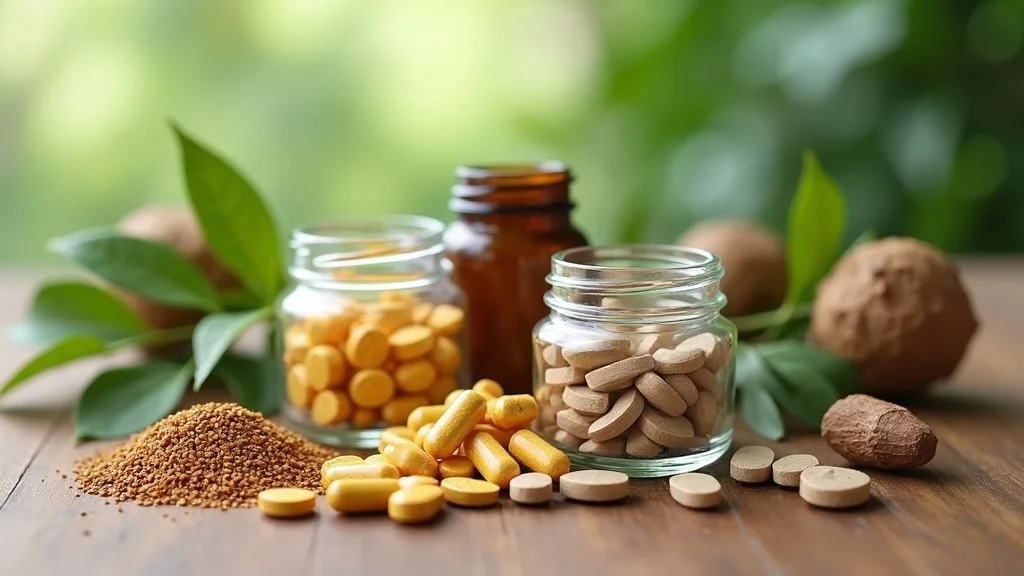Did you know? Almost a quarter of men over 30 have testosterone levels outside the normal range. This isn’t just an obscure lab value—it’s a silent issue quietly sabotaging energy, mood, and health worldwide. Read on for the urgent truths about testosterone levels, risks you can’t ignore, and how natural supplements can change the game for your well-being.
A Startling Look at Testosterone Levels: The Hidden Epidemic
When you hear “testosterone levels,” you might think of athletic performance or aging—but the reality is far more widespread. Recent studies highlight that up to 1 in 4 men over 30 show abnormal testosterone levels. This isn’t just about a drooping sex drive or muscle mass loss; imbalances in testosterone quietly undermine daily motivation, focus, mood, and even future health. Medical experts are now calling this a silent epidemic because symptoms are easy to brush aside or blame on stress, age, or busy schedules. Awareness is lacking, so thousands continue struggling with fatigue, irritability, and declining health without understanding the root cause. Recognizing and addressing low, high, or abnormal testosterone levels early can help prevent chronic risks down the line—from metabolic syndrome to cardiovascular issues, and even osteoporosis in later life.

"Recent studies show that up to 1 in 4 men over the age of 30 have abnormal testosterone levels. This silent epidemic impacts daily energy, mood, and quality of life."
What You'll Learn About Testosterone Levels
- The vital role testosterone levels play in overall health
- The differences between normal testosterone and abnormal testosterone
- Recognizing symptoms of low testosterone and high testosterone level issues
- Evidence on natural testosterone supplement benefits
- Practical lifestyle changes to support healthy testosterone levels
Understanding Testosterone Levels: What Are They and Why Do They Matter?
Your testosterone level isn’t just a number you get from a blood test. Testosterone is a powerful male sex hormone that affects everything from muscle mass and energy to mental sharpness and emotional well-being. It’s produced primarily in the testes but also in smaller amounts in the adrenal gland. In both men and women (although in much lesser quantities), testosterone plays an essential role in maintaining bone strength, mood stability, and even cognitive performance. Fluctuations in testosterone levels—whether a low level or a spike—can dramatically alter your body composition, sex drive, strength, and long-term health. Men typically experience a gradual decline as they age, but environmental and lifestyle factors can accelerate or amplify this process. The main concern isn’t just low testosterone; high testosterone and abnormal testosterone levels are equally disruptive and often missed. Medical professionals are increasingly urging regular monitoring of testosterone levels, especially as more men seek answers for unexplained fatigue, difficulty concentrating, or changes in mood and motivation.
Defining Testosterone Levels and Normal Testosterone Range
Testosterone levels are measured in nanograms per deciliter (ng/dL) by a simple blood test. For most adult men, the normal testosterone level ranges from about 300 to 1,000 ng/dL, though exact values may vary slightly by laboratory and region. Falling below or above this normal range signals abnormal testosterone—either low testosterone levels (<300 ng/dL) or high testosterone levels (often >1,000 ng/dL). While much focus lands on men, it’s crucial to note that women also require a stable level of testosterone for optimal health, albeit at a level roughly one-tenth that of men. “Normal” varies slightly due to factors like age, time of day (levels peak in the morning), physical health, and even stress or sleep patterns. The healthiest individuals tend to maintain testosterone close to the mid-high range, which supports sustained energy, sex drive, and body composition. Extreme deviations from the standard can result in symptoms of low testosterone or issues associated with high testosterone, both of which may require medical attention.
Why Maintaining Normal Testosterone Levels Is Crucial
Maintaining a normal testosterone level is vital for far more than physical strength or sexual function. This hormone’s influence spans across the body’s major systems. For men, normal testosterone means predictable muscle mass retention, clear mental focus, stable moods, and robust bone health. For women, it means balanced energy, emotional stability, and metabolic regularity. Gaps or spikes in testosterone levels can tip the balance toward symptoms like poor motivation, cognitive fog, or even higher susceptibility to chronic diseases. Low testosterone is linked to increased risk of osteoporosis, cardiovascular issues, and metabolic syndrome, while high testosterone may trigger aggression, acne, and sleep disturbances. Ultimately, stable testosterone within the normal range gives the body the ability to handle stress, recover from exercise, and maintain a healthy metabolism. Monitoring and managing testosterone is a crucial component of long-term quality of life.

"Normal testosterone levels are essential for maintaining muscle mass, mental sharpness, and emotional well-being."
Normal Testosterone Levels: What Should You Aim For?
So, what exactly is considered normal testosterone? For men, typical blood tests reveal total testosterone ranging from 300 to 1,000 ng/dL (nanograms per deciliter), with levels peaking in early adulthood and gradually declining after the age of 30. Women usually have a normal testosterone level between 15 and 70 ng/dL. However, it’s not just about hitting a number: feeling your best often requires testosterone to be in the upper end of your personal normal range. Anything below or above can trigger subtle or obvious changes in mood, muscle mass, and energy. It’s important to recognize that there’s no “one-size-fits-all” value—each person’s optimal zone is influenced by age, genetics, lifestyle, and medical history. Checking your testosterone level during a routine blood test (especially if you have unexplained symptoms) is the first step to identifying whether you’re outside the normal range. Working with your care provider helps establish if your levels signal a deeper health concern or are simply the natural result of aging.
Normal Testosterone Vs. Abnormal Testosterone Levels
The difference between normal and abnormal testosterone levels dramatically affects overall health. Lower-than-normal testosterone (<300 ng/dL for men) often triggers symptoms of low testosterone such as chronic fatigue, loss of muscle mass, reduced sex drive, and cognitive changes. High testosterone (>1,000 ng/dL) isn’t necessarily better—in fact, elevated levels can cause mood instability, increased aggression, acne, and potential risk for cardiovascular complications. Either end of the spectrum—low testosterone level or high testosterone level—can disturb hormonal balance and set the stage for long-term health risks. Recognizing symptoms early and regularly monitoring your testosterone with a blood test ensures you or your care provider can take steps to reclaim balance before more serious complications develop.
| Normal Testosterone | Low Testosterone | High Testosterone | |
|---|---|---|---|
| Measurement Range | Men: 300–1,000 ng/dL Women: 15–70 ng/dL |
Men: <300 ng/dL Women: <15 ng/dL |
Men: >1,000 ng/dL Women: >70 ng/dL |
| Symptoms | Optimized energy, normal sex drive, healthy muscle mass | Fatigue, low libido, mood changes, decreased muscle mass, cognitive difficulties | Increased aggression, acne, unexplained muscle gain, sleep disturbances |
| Common Causes | Healthy lifestyle, balanced diet, regular exercise | Aging, stress, medications, chronic illness, lifestyle factors | Supplement abuse, endocrine disorders, tumors, steroid use |
Factors Influencing Normal Testosterone Level
Understanding what shapes your normal testosterone level is crucial. Genetics play a fundamental role—some people naturally hover at the higher or lower end of the normal range. Age is a defining factor: testosterone levels gradually decline each year after age 30, making lifestyle even more critical as you age. Nutrition profoundly impacts hormone production; diets rich in healthy fats, quality proteins, and micronutrients like zinc help sustain optimal testosterone production. Chronic stress can suppress hormone synthesis, while inconsistent sleep patterns may drop testosterone levels overnight. Environmental toxins—such as plastics (BPA), pesticides, or heavy metals—can disrupt endocrine glands, including the pituitary gland and adrenal glands which regulate testosterone. Finally, medical conditions such as obesity, Type 2 diabetes, or testicular injury can interrupt the typical production or release of this vital sex hormone. Proactive lifestyle adjustments provide a first line of defense in nurturing and maintaining healthy testosterone.

Low Testosterone Level: Symptoms, Causes, and Risks
Low testosterone levels, also known as testosterone deficiency, are increasingly common and can surface at any age. Men aren’t the only ones at risk—women can experience a low testosterone level and similar symptoms. Recognizing and addressing this hormone imbalance early can stave off more serious complications. Experts estimate that about 40% of men over the age of 45 may have low testosterone, and most don’t realize it. Early warning signs are often subtle and attributed to stress, aging, or poor sleep, making it crucial to recognize possible symptoms as soon as they appear. Understanding both the common causes and risks attached to untreated low testosterone levels is the first step to regaining control of your vitality and long-term health.
Recognizing Symptoms of Low Testosterone
The symptoms of low testosterone are broad, often developing slowly, and are frequently overlooked. Common complaints range from unexplained fatigue and a noticeable drop in sex drive to mood swings and trouble focusing. For men, additional red flags include reduced muscle mass, increased belly fat, frequent irritability, and even hot flashes. Women with low testosterone can also experience sluggishness, weakened bones, and diminished motivation. These symptoms may initially seem disconnected, but together they represent your body's plea for help. If you’re struggling with any combination of these issues, it’s worth discussing your concerns with a care provider. They’ll likely recommend a blood test, which is the most reliable way to diagnose a low level of testosterone and rule out other underlying conditions.
- Fatigue
- Low libido
- Mood changes
- Decreased muscle mass
- Cognitive difficulties
Common Causes of Low Testosterone Levels in Men
Several factors can trigger a lower-than-normal testosterone level in men. Aging is the most common reason, as the body’s natural hormone production slows with each decade. Illnesses affecting the testicles, pituitary gland, or adrenal glands can disrupt normal production as well. Chronic health conditions—such as Type 2 diabetes, obesity, high blood pressure, and metabolic syndrome—are closely tied to declining testosterone. Certain medications, including opioids and steroids, suppress hormone synthesis, as do anabolic steroid misuse and previous cancer therapies. Mental or emotional stress, poor sleep, and excessive alcohol use may also deplete testosterone, compounding the risk. Finally, poor diet and sedentary lifestyle further lower testosterone, while illness or injury to the testicles can shut down production altogether. Addressing these causes early gives you the best shot at reversing symptoms of low testosterone and regaining optimal health.

Long-Term Health Risks Associated With Low Testosterone
The risks of leaving low testosterone levels untreated extend far beyond sex drive or motivation. Prolonged hormone deficiency accelerates bone loss, making osteoporosis and fractures a real threat even for otherwise healthy adults. Cardiovascular risks climb, with links to arterial stiffness, high cholesterol, and greater susceptibility to heart disease. Mental health also suffers: low testosterone is linked to both depression and increased irritability. The risk for metabolic disorders rises, as testosterone plays a key role in fat metabolism and muscle preservation. Over the long term, these combined effects undermine physical, emotional, and cognitive resilience, diminishing quality of life and shortening healthy lifespan. If you suspect symptoms of low testosterone, early intervention is critical.
"Untreated low testosterone levels can increase the risk of osteoporosis, cardiovascular disease, and depression."
Abnormal Testosterone: High Testosterone Level and Its Impacts
Just as dangerous as low testosterone, high testosterone levels also introduce notable health challenges. While high testosterone is less common, men using anabolic steroids or certain supplements without proper oversight are most at risk. Symptoms often look appealing at first—like increased muscle mass or energy—but quickly reveal drawbacks such as irritability, sleep problems, and changes in skin health. High testosterone can even mask underlying endocrine disorders. Recognizing when your testosterone exceeds a healthy threshold gives you the chance to course-correct, naturally or with medical guidance, before experiencing serious side effects.
Symptoms and Signs of High Testosterone Levels
Warning signs of a high testosterone level may be subtle initially but escalate if the hormone remains unchecked. A sudden surge can cause increased aggression, mood swings, and irritability that disrupt everyday interactions. The skin may become oily or erupt in acne, sometimes mimicking a teenager’s complexion. An unexplained boost in muscle mass, especially if not accompanied by lifestyle changes, signals that your body is making (or receiving) too much testosterone. Many also report difficulty sleeping or persistent restlessness. While these may sound like athletic advantages, they often come at a hidden cost to long-term health and stability.
- Increased aggression
- Acne and oily skin
- Unexplained muscle gain
- Sleep disturbances
Risks and Complications of High Testosterone
A persistently high testosterone level is associated with a spectrum of health problems. Over time, abnormally high testosterone raises your risk for liver damage, heart disease, and excessive blood clotting. Some men may experience prostate enlargement or even increased risk for prostate cancer. High testosterone disrupts cholesterol balance, leading to negative impacts on heart health. Other complications include infertility (due to hormonal feedback loops), reduced sperm count, and adverse mood changes that can harm personal relationships. Reducing risk means identifying the earliest warning signs and opting for solutions—such as natural testosterone supplements—that restore balance without overshooting your body’s natural set point.

Natural Ways to Support Healthy Testosterone Levels
"Lifestyle choices can meaningfully impact testosterone levels—diet, sleep, and exercise matter more than you think."
Optimizing testosterone levels doesn’t have to mean prescription therapies or risky injections. Research shows that specific lifestyle changes can powerfully influence your hormone profile. Both low testosterone and high testosterone can often be mitigated—or even prevented—by focusing on diet, exercise, stress management, and sleep hygiene. Natural testosterone supplements, based on herbs, minerals, and vitamins, are gaining popularity because they offer support without disrupting the body’s natural hormone regulation. These strategies target root causes, enhance endocrine function, and allow your testosterone levels to normalize from within.
Diet, Nutrition, and Testosterone Level Support
The foods you eat lay the foundation for hormone health. A Mediterranean-style diet—rich in colorful vegetables, healthy fats (especially olive oil), lean proteins, nuts, and whole grains—provides nutrients essential for normal testosterone production. Key players include zinc (found in meat, nuts, and seeds), healthy cholesterol (for hormone synthesis), vitamin D, and magnesium. Balanced nutrition supports the adrenal glands and pituitary gland, which regulate sex hormone release. Avoiding excess sugars, trans fats, processed foods, and alcohol also protects your testosterone levels from avoidable drops. By upgrading your plate, you can optimize hormone function, stabilize energy, and cultivate an environment in which normal testosterone levels thrive.

Exercise, Stress Management, and Testosterone Levels
Regular physical activity is a proven enhancer of total testosterone, particularly strength training and high-intensity interval workouts. These forms of exercise send signals to the endocrine system that encourage natural hormone release. Pairing movement with consistent, restorative sleep ensures that testosterone levels remain in their normal range, as most hormone production occurs during deep sleep cycles. Managing chronic stress—through meditation, breathing exercises, or hobbies—also protects testosterone by lowering cortisol, the “stress hormone,” which suppresses testosterone synthesis. Even moderate amounts of daily movement, like brisk walking or jogging, can limit the decline of normal testosterone as you age. When lifestyle changes become habit, your body’s hormonal rhythm strengthens, setting you up for long-term health.

The Role of Natural Testosterone Supplements
Why Choose a Natural Testosterone Supplement Over Prescription Therapy?
"Natural testosterone supplements are linked to fewer side effects and support hormonal health holistically."
Prescription testosterone therapy often delivers rapid results, but it also carries well-documented side effects: dependency, risk of overcorrection (leading to high testosterone), and suppression of your body’s own hormone production. In contrast, natural testosterone supplements use herbs, minerals, and amino acids to nudge your body’s hormone machinery—helping you restore balance without overwhelming your system. Research supports these natural options for improving symptoms linked to both low and abnormal testosterone levels: increased energy, better mood, enhanced libido, and greater muscle retention. For those interested in long-term health or hesitant about pharmaceuticals, a natural supplement offers powerful support with a fraction of the risks. Always select high-quality, third-party tested products for best results.
Popular Ingredients in Natural Testosterone Supplements
- Fenugreek
- Zinc
- D-Aspartic Acid
- Ashwagandha

Research Evidence on Natural Testosterone Supplements
Several clinical studies now validate the use of natural supplements for supporting testosterone levels. Ashwagandha has been shown in randomized trials to boost testosterone and reduce cortisol, tackling two causes of hormone imbalance in one. Fenugreek seeds may increase sexual function and promote muscle mass without harmful side effects found in synthetic hormones. D-Aspartic acid plays a key role in the synthesis of male sex hormone in both men and women, while supplemental zinc is proven to enhance hormonal balance, especially where diets are deficient. Unlike testosterone therapy, these natural approaches gently correct underlying deficiencies, reducing the occurrence and risk of high testosterone or overcompensation. Choosing scientifically-backed ingredients ensures maximum benefit with minimal risk—making natural testosterone supplements a first-choice solution for many looking to reclaim normal testosterone levels.
Testosterone Therapy: What You Need to Know
Medical vs. Natural Solutions: Pros and Cons
When it comes to testosterone therapy, the main divide is between prescription options and natural solutions. Prescription therapies typically involve testosterone injections, gels, or patches—these offer quick symptom relief, particularly for those with confirmed testosterone deficiency. However, they’re associated with risks such as dependence, fertility suppression, heart complications, and mood swings from unsteady dosing. In contrast, natural testosterone supplements target the body’s own production pathways and avoid these complications. They’re accessible without a prescription, usually affordable, and are generally well tolerated with consistent use. Natural approaches are best suited for those with mild-to-moderate symptoms or those wishing to avoid pharmaceuticals, while medical therapies may be necessary for severe testosterone deficiency diagnosed through a blood test.
| Criteria | Prescription Testosterone Therapy | Natural Testosterone Supplement |
|---|---|---|
| Efficacy | Rapid symptom relief Effective for severe deficiencies |
Gradual improvement Supports mild-to-moderate symptoms |
| Side Effects | Higher risk: dependency, fertility loss, cardiovascular strain, mood swings | Minimal risk: rare allergies or digestive upset |
| Cost | High; ongoing doctor visits and prescriptions | Affordable; available over-the-counter |
| Long-Term Outcomes | Risk of natural hormone suppression; requires continued monitoring | Supports natural hormone production; safe for longer use |
People Also Ask: Answers About Testosterone Levels
How do I increase my testosterone levels?
Boosting testosterone levels naturally involves a combination of healthy habits: eat a nutrient-rich diet (think Mediterranean, with plenty of zinc and healthy fats), exercise regularly with a mix of strength and aerobic training, manage stress, ensure restorative sleep, and consider proven natural supplements like fenugreek or ashwagandha. Avoid smoking, limit alcohol, and check your medications for hormone side effects. If you suspect persistent low testosterone or have risk factors, consult your care provider for a blood test to determine your starting point and assess the need for further intervention.
What is a low testosterone level in men?
For most adult men, a low testosterone level is defined as total testosterone below 300 ng/dL on a blood test. Symptoms may include fatigue, reduced sex drive, loss of muscle mass, mood changes, and cognitive difficulties. Because levels can vary by time of day and individual factors, your care provider may suggest repeat testing to confirm the diagnosis before considering treatment options like natural testosterone supplements or medical therapy.
What is considered low testosterone in Australia?
In Australia, guidelines are similar: cutoff for low testosterone in men generally falls below 8–12 nmol/L, which equates to approximately 230–350 ng/dL. Some medical organizations use slightly different ranges, so it’s vital to discuss individual results with your healthcare professional. Symptoms and health status always guide next steps, not just numbers alone.
What happens if testosterone is low?
If testosterone levels remain low, you might experience persistent fatigue, reduced muscle and bone mass, decreased libido, mood and memory changes, and increased cardiovascular risks. Over time, untreated testosterone deficiency can contribute to osteoporosis, obesity, diabetes, and heart disease. The earlier you address the issue—whether with lifestyle tweaks, a natural testosterone supplement, or medical intervention—the better your chances of regaining energy, mood, and health.
Key Takeaways on Testosterone Levels for Optimal Health
- Testosterone levels affect multiple aspects of health
- Abnormal testosterone levels—either low or high—present risks
- Natural strategies and supplements can effectively help maintain healthy testosterone levels
FAQs: Testosterone Levels and Your Health
Can women have low testosterone levels?
Yes. Although women have much lower testosterone levels, they can still experience symptoms—like fatigue, mood changes, or bone loss—if their levels drop below the normal female range. A blood test can confirm if low testosterone is involved, and natural approaches are often recommended as first-line support.
Are there risks to using natural testosterone supplements?
When chosen wisely, natural testosterone supplements have minimal risks, with rare cases of allergies or mild stomach upset. Look for reputable brands with transparent ingredient lists. If you have a chronic medical condition or are taking other medications, discuss supplement use with your care provider.
How often should testosterone levels be checked?
Routine screening isn’t necessary for everyone. If you have persistent symptoms—fatigue, libido changes, or mood swings—a blood test is advised. For those on testosterone therapy or managing chronic illness, levels may be checked every 3–12 months; consult your provider for personalized intervals.
Is a high testosterone level dangerous?
Yes, persistently high testosterone—especially from excessive supplementation or steroid use—can lead to liver and heart problems, mood swings, infertility, and increased risk for certain cancers. Always aim for hormone balance, and consider natural support over pharmaceutical extremes.
Ready to Support Your Testosterone Levels? Try a Natural Testosterone Supplement Today
Take charge of your well-being and reclaim your energy and health by supporting your testosterone the natural way. Shop a trusted natural testosterone supplement here!
 Add Row
Add Row  Add
Add 




Write A Comment